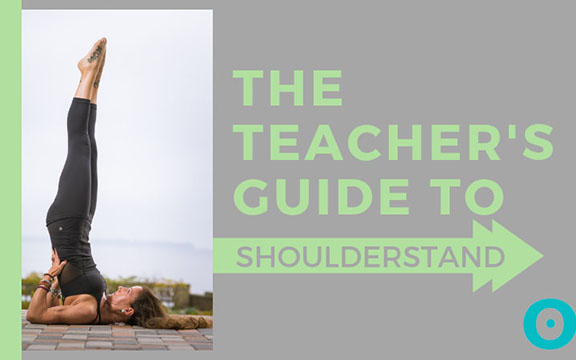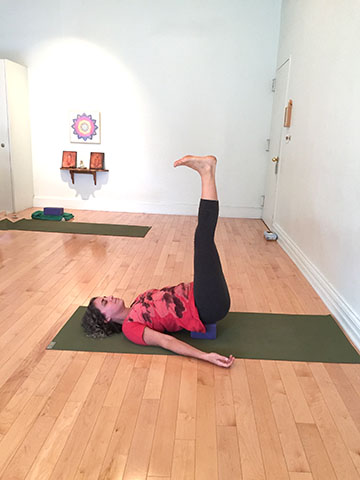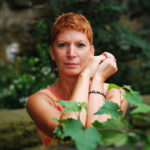 Over the past years, an asana controversy arose in the Yoga world concerning the shoulder stand (sarvangasana). How does this pose affect the health of the cervical spine, and is it safe for everyone, particularly beginners? Of course, we Integral Yoga teachers know the contraindications related to actually practicing this pose, but new concerns are directly related to the rampant use of all our hi-tech devices.
Over the past years, an asana controversy arose in the Yoga world concerning the shoulder stand (sarvangasana). How does this pose affect the health of the cervical spine, and is it safe for everyone, particularly beginners? Of course, we Integral Yoga teachers know the contraindications related to actually practicing this pose, but new concerns are directly related to the rampant use of all our hi-tech devices.
Today’s Yoga students regularly use computers, tablets, smart phones, and other gadgets that increase the tendency to thrust the head forward or tilt it down toward the chest. These habitual patterns of movement decrease the natural cervical curve. And this curve is very important to maintain a healthy spinal structure.
The cervical spine is naturally in extension (concave curve); it is beautifully designed to support the weight of the head. If too many of our waking hours are spent with the head thrusting forward, or dropping, the cervical spine will begin to lose its curve and actually flatten. The muscles that support the vertebrae will overstretch, and the strong ligaments that extend alongside the spine will weaken.
So What is Happening?
When the shoulder stand is practiced frequently without proper support of the cervical spine, neck problems will almost certainly result, especially if the neck curve is already diminished. If the back of the neck is flattened against the floor over and over again, the natural curve will be compromised.
What to Do?
At the Integral Yoga Institute of New York, we have been encouraging all our teachers (not only new teachers) to offer alternatives to a full shoulder stand—suggestions for practice to help maintain the cervical curve—and for teachers to give their students intelligent and mindful instructions.

Block
Block Underneath the Sacrum
One of our favorite alternative poses, that is safe, accessible, and easily taught to just about everyone, utilizes blocks. Most students are quite comfortable in this pose. To prepare, have the students come into a gentle sethu bandasana (bridge pose), so they can easily bring the block under the sacrum. The widest side of the block should be placed horizontally under the sacrum. Remember, the sacrum is located at the base of the spine between the two sides of the pelvis. It is heart shaped, comprised of approximately five fused vertebrae. The student will definitely be uncomfortable if the block is placed incorrectly above the sacrum, under the irregular bones of the lumbar spine. Once the block is in place, ask the student to take the feet off of the mat, bending the knees toward the chest and then straightening the legs, with feet toward the ceiling. The upper body remains relaxed, as in savasana. Hold for 1-3 minutes. The following variations may also be held for a similar length of time.
Blanket

Blanket
Blankets offer cushioning and will support the cervical spine in shoulder stand. Use at least two folded blankets. Place one blanket on top of the other with the folded edge toward the top of the mat and the fringed edge toward the bottom. Put the stacked blankets near the top of the mat, leaving about a hand’s length of mat empty at the top. Lie back onto the blankets with the shoulders positioned slightly below the folded edge and the head and neck off the blankets, resting on the mat. The student may want to fold the bottom of the mat over the blankets leaving about a hand’s length of blanket exposed from the top. This option can provide traction for the upper arms on the sticky mat. Finally, ask the student to move into shoulder stand, utilizing the instructions offered in the Level I manual, to come into classic shoulder stand.
Wall Progression
This is one of the safest ways to practice the shoulder stand. Begin by bringing the legs up the wall with the hips/buttocks touching or, at least, very close to the wall. Legs up the wall is a wonderful pose unto itself, with excellent benefits! The students may choose to stay right here with the option to place a blanket under the hips and sacrum. If students wishe to continue with the wall progression, they may:
1. Bend the knees to place the feet on the wall.
2. Press the feet against the wall, lift the hips, lower and middle back off the mat, and moving the chest towards the chin.
3. Bend the elbows, place the hands on the back, and press against the back to lift the torso a little more.
4. Continue by keeping the feet on the wall, extending the legs so the entire body is at an angle. While maintaining the angle of the trunk, begin to take one leg away from the wall and then the other, pressing down through the shoulders and reaching out through the legs. The legs are more in a pike position rather than vertical.

1

2

3 & 4
Pike Position

Pike position
Pike position shoulder stand (also called ardha sarvangasana) is yet another safe way of practicing an inversion. It is important to mention that each stage of this progression offers an opportunity to help students recognize their comfort zone or lack there of. Encourage students to be present and to not feel compelled to move on, if the body/mind resists.
In Conclusion
Keep your students safe. Encourage them to experiment with all these variations of sarvangasana. When in doubt, you can’t go wrong with legs up the wall. Just about every Hatha Yoga practitioner enjoys this pose, including us, Kali and Rashmi! Always remember the “Three Cs” that describe a great Yoga teacher: confidence, clarity, and compassion!
About the Teachers:
 Kali Morse, E-RYT 500, RPYT, C-IAYT, is director of the Teacher Training programs at the New York Integral Yoga Institute. Kali’s dedication and service to the art and science of Yoga spans four decades. She has taught Yoga in many settings including schools, colleges, hospitals, businesses, etc. She is certified to teach Integral Hatha Levels I, II, and III, Meditation, Raja Yoga, Prenatal and Postnatal Yoga, Children’s Yoga, and Therapeutic Yoga.
Kali Morse, E-RYT 500, RPYT, C-IAYT, is director of the Teacher Training programs at the New York Integral Yoga Institute. Kali’s dedication and service to the art and science of Yoga spans four decades. She has taught Yoga in many settings including schools, colleges, hospitals, businesses, etc. She is certified to teach Integral Hatha Levels I, II, and III, Meditation, Raja Yoga, Prenatal and Postnatal Yoga, Children’s Yoga, and Therapeutic Yoga.
 Rashmi Galliano, E-RYT 500, RPYT, is a certified Hatha II, Hatha III, Gentle, and Prenatal Integral Yoga teacher and has been teaching since 2006. She is one of Integral Yoga’s senior teacher trainers. Rashmi is also certified as a teacher of Prana Yoga with Jeff Migdow, M.D., through the Open Center in New York City; of Vinyasa Yoga with Stephanie Keach in Asheville, North Carolina; of Yoga Anatomy with Leslie Kaminoff at the Breathing Project in New York City; and of “Relax and Renew” Yoga through Judith Lasater. She has training in Reiki levels 1 and 2 from Tom Capshew.
Rashmi Galliano, E-RYT 500, RPYT, is a certified Hatha II, Hatha III, Gentle, and Prenatal Integral Yoga teacher and has been teaching since 2006. She is one of Integral Yoga’s senior teacher trainers. Rashmi is also certified as a teacher of Prana Yoga with Jeff Migdow, M.D., through the Open Center in New York City; of Vinyasa Yoga with Stephanie Keach in Asheville, North Carolina; of Yoga Anatomy with Leslie Kaminoff at the Breathing Project in New York City; and of “Relax and Renew” Yoga through Judith Lasater. She has training in Reiki levels 1 and 2 from Tom Capshew.
Disclaimer: We offer only information and no medical advice. You should consult a medical practitioner before starting any new exercise regime. This is particularly important if you are overweight, pregnant, nursing, regularly taking medications, or have any existing medical conditions. This website may not be tailored to your current physical and mental health. We accept no liability whatsoever for any damages arising from the use of this website.

